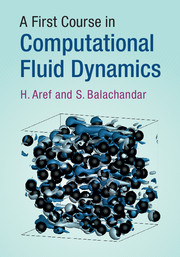Book contents
- Frontmatter
- Contents
- Preface
- 1 CFD in Perspective
- 2 Mappings
- 3 Ordinary Differential Equations: Initial Value Problem
- 4 Spatial Discretization
- 5 Boundary Value and Eigenvalue ODEs
- 6 Methods Based on Functional Expansions
- 7 Partial Differential Equations
- 8 Multi-dimensional Partial Differential Equations
- References
- Index
4 - Spatial Discretization
Published online by Cambridge University Press: 03 October 2017
- Frontmatter
- Contents
- Preface
- 1 CFD in Perspective
- 2 Mappings
- 3 Ordinary Differential Equations: Initial Value Problem
- 4 Spatial Discretization
- 5 Boundary Value and Eigenvalue ODEs
- 6 Methods Based on Functional Expansions
- 7 Partial Differential Equations
- 8 Multi-dimensional Partial Differential Equations
- References
- Index
Summary
In the previous chapter we considered initial value ODEs, where the interest was in the computation of time evolution of one or more variables given their starting value at some initial time. There is no inherent upper time limit in integrating these initial value ODEs. Therefore numerical methods for their solution must be capable of accurate and stable long time integration. By contrast, in the case of two-point boundary value and eigenvalue problems for ODEs arising in fluid mechanics, the independent space variable has two well-defined end points with boundary conditions specified at both ends. The spatial domain between the two boundary points can be infinite, as in the case of Blasius boundary layer: see (1.6.5), where the spatial domain extends from the wall (η = 0) out to infinity (η → ∞). For such a problem it is possible to treat the space variable much like time in an initial value problem, and proceed with integration from one boundary to the other and then subsequently verify the boundary conditions at the other end. We shall consider numerical methods of this sort in the next chapter.
An alternative approach is to discretize the entire domain between the two boundaries into a finite number of grid points and to approximate the dependent variables by their grid point values. This leads to a system of equations that can be solved simultaneously. Much like the time integration error considered in the previous chapter, here one encounters a discretization error. The discretization error arises from several sources: interpolation errors arise from approximating the function between grid points; differentiation errors arise in the approximation of first-, second- and higher-order derivatives; and integration errors arise from the numerical integration of a function based on its discretized values at the grid points. These errors are indeed interrelated and depend on the discretization scheme. This chapter will consider various discretization schemes. In particular, discrete approximations to the first- and second-derivative operators will be obtained. Errors arising from the different discretization schemes will be considered. The concept of discrete approximation to the first and second derivatives as matrix operators will be introduced. Finally, we will consider spatial discretization as a means to numerically integrate functions. The actual solution methodologies for two-point boundary value and eigenvalue problems for ODEs, using the tools developed in this chapter, are treated in Chapter 5.
Information
- Type
- Chapter
- Information
- A First Course in Computational Fluid Dynamics , pp. 118 - 165Publisher: Cambridge University PressPrint publication year: 2017
